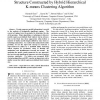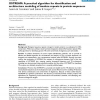116 search results - page 4 / 24 » A new algorithm for detecting low-complexity regions in prot... |
RECOMB
2002
Springer
14 years 7 months ago
2002
Springer
A recent idea for determining the three-dimensional structure of a protein uses antibody recognition of surface structure and random peptide libraries to map antibody epitope comb...
BIBM
2008
IEEE
14 years 1 months ago
2008
IEEE
— Protein sequence motifs information is crucial to the analysis of biologically significant regions. The conserved regions have the potential to determine the role of the protei...
BMCBI
2007
13 years 7 months ago
2007
Background: Biological sequence repeats arranged in tandem patterns are widespread in DNA and proteins. While many software tools have been designed to detect DNA tandem repeats (...
BMCBI
2010
13 years 7 months ago
2010
Background: Natively unfolded proteins lack a well defined three dimensional structure but have important biological functions, suggesting a re-assignment of the structure-functio...
ISMB
1996
13 years 8 months ago
1996
We have developed a hidden Markov model (HMM)to detect the protein coding regions within one megabase contiguous sequence data, registered in a database called GenBankin eight ent...


